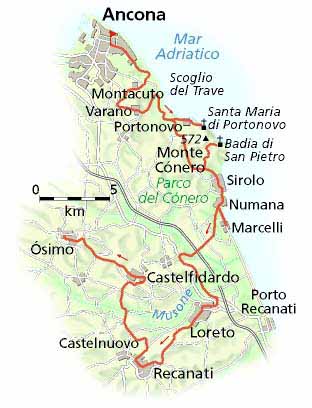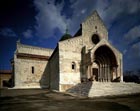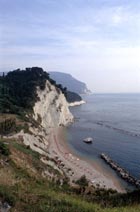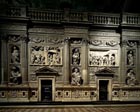The Rosso Conero Tour
 The DOC Rosso Conero territory is covered by a circular route from Ancona that returns to the city via the splendid natural beauty of the Conero Nature Park, the hills of the hinterland towards Recanati and Loreto, and the towns of Castelfidardo and Osimo. The area includes the entire neighbourhood of Mount Conero itself and some favourite tourist haunts such as Portonovo, Sirolo and Numana before going as far south as Recanati, then west to Loreto, Castelfidardo, Osimo and Fabriano.
The DOC Rosso Conero territory is covered by a circular route from Ancona that returns to the city via the splendid natural beauty of the Conero Nature Park, the hills of the hinterland towards Recanati and Loreto, and the towns of Castelfidardo and Osimo. The area includes the entire neighbourhood of Mount Conero itself and some favourite tourist haunts such as Portonovo, Sirolo and Numana before going as far south as Recanati, then west to Loreto, Castelfidardo, Osimo and Fabriano.

Ancona
 The regional capital of the Marches is a city rich in contrasts: the steep narrow streets climbing up through the old town centre suddenly open up to views of the sea and the ancient cathedral dominates both the light-coloured noble residences and the ships in the great commercial port from on high. Ancona was founded a very long time ago, on one of the last slopes of Mount Conero, around a large inlet which made it one of the most important ports in the Mediterranean for centuries. Even today, the Vanvitelli promenade (where the port structures designed by Luigi Vanvitelli in the 18th c. still stand) projects the city’s historical charm onto a background of modern port activity, while the Passetto, the long sea front promenade to the South, skirts the steep cliffs and precipices descending from the promontory.
The regional capital of the Marches is a city rich in contrasts: the steep narrow streets climbing up through the old town centre suddenly open up to views of the sea and the ancient cathedral dominates both the light-coloured noble residences and the ships in the great commercial port from on high. Ancona was founded a very long time ago, on one of the last slopes of Mount Conero, around a large inlet which made it one of the most important ports in the Mediterranean for centuries. Even today, the Vanvitelli promenade (where the port structures designed by Luigi Vanvitelli in the 18th c. still stand) projects the city’s historical charm onto a background of modern port activity, while the Passetto, the long sea front promenade to the South, skirts the steep cliffs and precipices descending from the promontory.
Cattedrale
 In this small city, located on a hill between Musone and Potenza valleys, crossed by quiet roads that go up among handsome mansions, were born, after a little more than a century, two very different characters between them: the poet Giacomo Leopardi and the tenor Beniamino Gigli. The country seems to feed on the Leopardi’s memories: the poet left very early the parental home and the familiar landscapes, but he drew inspiration constantly from those (the bell tower of the monastery of St. Augustine is the "old tower" of Passero Solitario; there is also a Colle dell'Infinito, on Mount Tabor, which can be reached with a short walk). The Municipal Art Gallery, finally, preserves a rich collection of works by Lorenzo Lotto (XVI century).
In this small city, located on a hill between Musone and Potenza valleys, crossed by quiet roads that go up among handsome mansions, were born, after a little more than a century, two very different characters between them: the poet Giacomo Leopardi and the tenor Beniamino Gigli. The country seems to feed on the Leopardi’s memories: the poet left very early the parental home and the familiar landscapes, but he drew inspiration constantly from those (the bell tower of the monastery of St. Augustine is the "old tower" of Passero Solitario; there is also a Colle dell'Infinito, on Mount Tabor, which can be reached with a short walk). The Municipal Art Gallery, finally, preserves a rich collection of works by Lorenzo Lotto (XVI century).
Portonovo
The church of Santa Maria di Portonovo, a real jewel of Romanesque architecture in the Marches, is situated in this small village on the Conero Riviera. Built out of great blocks of light-coloured stone by the Benedictine fathers around 1050, it unifies the design of the basilica, built on the plan of a Greek cross and surmounted by a dome. Not far from the church, there is a small Napoleonic blockhouse, a military bulwark built in 1808 and now transformed into a hotel.
Sirolo
 There are wonderful panoramic views of the Adriatic and the slopes of Mount Conero from the houses and squares of this small fortified village set high above the sea: The famous Due Sorelle, two needles of white calcareous rock, emerge from the sea not far from the village. The narrow streets and stretches of medieval walls (like Torrino’s ramparts) still reflect the origins of Sirolo, which was enclosed by walls (11th c.) straight after its founding in the Middle Ages. The picturesque streets and squares contain some beautiful churches like the Madonna del Rosario (with 16th-c. frescoes) and the church of the Santissimo Sacramento.
There are wonderful panoramic views of the Adriatic and the slopes of Mount Conero from the houses and squares of this small fortified village set high above the sea: The famous Due Sorelle, two needles of white calcareous rock, emerge from the sea not far from the village. The narrow streets and stretches of medieval walls (like Torrino’s ramparts) still reflect the origins of Sirolo, which was enclosed by walls (11th c.) straight after its founding in the Middle Ages. The picturesque streets and squares contain some beautiful churches like the Madonna del Rosario (with 16th-c. frescoes) and the church of the Santissimo Sacramento.
Numana
 This small maritime village on the edge of the Conero Promontory has a very ancient history: it did in fact begin its days as a port for the Pre-Roman Picene people before becoming a municipium of Rome. Today it is a popular tourist resort, set around a small port and crossed by a long picturesque stairway called the Costarella; a wooden crucifix (Romanesque, end of 12th c.), to which miraculous properties are attributed, is kept in the church of the Madonna del Crocifisso.
This small maritime village on the edge of the Conero Promontory has a very ancient history: it did in fact begin its days as a port for the Pre-Roman Picene people before becoming a municipium of Rome. Today it is a popular tourist resort, set around a small port and crossed by a long picturesque stairway called the Costarella; a wooden crucifix (Romanesque, end of 12th c.), to which miraculous properties are attributed, is kept in the church of the Madonna del Crocifisso.
Loreto
 According to tradition, one night many centuries ago, a small group of angels flew from Palestine carrying Jesus' house from Nazareth and deposited it on this elongated hill in front of the Adriatic, between the Potenza and Musone valleys. Loreto, immersed in its gentle scenery, is one of the main Italian pilgrimage centres along with Rome and San Giovanni Rotondo (linked with Padre Pio). The Sanctuary of the Santa Casa , built on an impressive fortification, dates back to the 15–16th c., although the origins of the cult are believed to be much older (probably 13th c.): the small masonry building believed to be the house of Jesus when he was a child is enclosed in a magnificently carved marble casing ( the work of Bramante, 1509) and is in turn contained within the great Late-Renaissance church which was worked on by the best architects and sculptors of its day.
According to tradition, one night many centuries ago, a small group of angels flew from Palestine carrying Jesus' house from Nazareth and deposited it on this elongated hill in front of the Adriatic, between the Potenza and Musone valleys. Loreto, immersed in its gentle scenery, is one of the main Italian pilgrimage centres along with Rome and San Giovanni Rotondo (linked with Padre Pio). The Sanctuary of the Santa Casa , built on an impressive fortification, dates back to the 15–16th c., although the origins of the cult are believed to be much older (probably 13th c.): the small masonry building believed to be the house of Jesus when he was a child is enclosed in a magnificently carved marble casing ( the work of Bramante, 1509) and is in turn contained within the great Late-Renaissance church which was worked on by the best architects and sculptors of its day.
Recanati
 Two very different people were born a little more than a century apart in this small quiet town with its peaceful streets climbing among the beautiful noblemen’s residences, set on a hill between the valleys of the Musone and Potenza: the poet Giacomo Leopardi and the tenor Beniamino Gigli. The village seems to live off these memories of Leopardi: the poet left his father’s house and its familiar scenery very early on but continually drew inspiration from them (the bell tower of the convent of San Agostino is the ‘ancient tower’ in the Lonely Sparrow; there is even a Colle dell’Infinito on Mount Tabor which can be reached after a short walk). Finally, a rich collection of works by Lorenzo Lotto (16th c.) is kept in the municipal Art Gallery.
Two very different people were born a little more than a century apart in this small quiet town with its peaceful streets climbing among the beautiful noblemen’s residences, set on a hill between the valleys of the Musone and Potenza: the poet Giacomo Leopardi and the tenor Beniamino Gigli. The village seems to live off these memories of Leopardi: the poet left his father’s house and its familiar scenery very early on but continually drew inspiration from them (the bell tower of the convent of San Agostino is the ‘ancient tower’ in the Lonely Sparrow; there is even a Colle dell’Infinito on Mount Tabor which can be reached after a short walk). Finally, a rich collection of works by Lorenzo Lotto (16th c.) is kept in the municipal Art Gallery.
Castelfidardo
 In 1863, not far from the sea, in this elongated small town set on a on a hill dividing the valleys of Aspio and Musone rivers, an artisan came up with the idea of opening a shop selling musical instruments. Since then, Castelfidardo has become the international capital of the accordion, producing musical instruments renowned throughout the world and celebrated in the local International Museum of the Accordion. The centre looks 18th c.; only four gates and a few stretches of the walls remain of the ancient castle which gave the village its name, with a few ancient houses leaning against them.
In 1863, not far from the sea, in this elongated small town set on a on a hill dividing the valleys of Aspio and Musone rivers, an artisan came up with the idea of opening a shop selling musical instruments. Since then, Castelfidardo has become the international capital of the accordion, producing musical instruments renowned throughout the world and celebrated in the local International Museum of the Accordion. The centre looks 18th c.; only four gates and a few stretches of the walls remain of the ancient castle which gave the village its name, with a few ancient houses leaning against them.
Osimo
Osimo is a village of Roman origins stretched out along the ridge which separates the valleys of the Aspio and Musone rivers. Hardly any traces remain of the ancient Roman city called Auximum: there are only an ancient fountain, Fonte Magna, set in a wall of tufa blocks and a series of 12 decapitated statues discovered in the area of the roman Forum and now kept in the town hall. These statues gave rise to an ancient nickname for the inhabitants of Osimo: ‘the headless ones’. The historical centre of the village, however, reflects its long medieval period of prosperity: the duomo (cathedral), dedicated to San Leopardo (12th c.), is worth visiting.
|
THE PLEASURES OF THE TABLE |
|
| Ciauscolo | Salame e soppressata di Fabriano |
| This is the traditional salami of the Marches hinterland and comes originally from the Visso district in the Monti Sibillini Nature Park. But you can now find it everywhere; so much so that it has become a gastronomic symbol for the entire Marches region. Made of pancetta, shoulder and entrecôte of pork, minced finely and seasoned with salt, pepper, garlic and reduced wine. Stuffed into natural casing and then smoked for a few days over juniper berries before 2 or 3 months’ ageing. A soft sausage, best eaten spread over a slice of home-made bread. | The salami is made by chopping the pork thigh into matchsticks, seasoning it with salt and pepper, putting it into a casing and ageing it. This is one of the simplest salami preparations in Italy. Ageing varies between 60 and 150 days. Dense and solid in texture, knobbly to touch, and covered with a light skin of mould. Deep red in colour when sliced open and composed of fine meat granules dotted with white lard. The soppressata is a much thicker sausage than the salami. The meat comes from lean parts of the pig and is repeatedly minced before the addition of little cubes of lard. Once seasoned with salt and pepper, the mixture is stuffed into natural veal casings. |
| Salamino di fichi | Beccute |
| A typical regional dessert made from chopped dried figs, hazelnuts and almonds, mixed into a paste with “sapa” (concentrated wine must) and “mistrà”, a typical anise-based liqueur from the Marches. The resulting paste is shaped into small salami forms (hence “salamino”), wrapped and held together with fig leaves. Given the ingredients, the season for the preparation of this dish is late summer, ready to be eaten in the winter. The resulting salamini are kept in cool cellars. | Little rolls of sweet maize-flour dough, baked and dotted with pine nuts and sultanas. Made in the pasticceria shops of Ancona, Fano and other districts on the Adriatic coast or in the hinterland. |
|
THE WINE |
| In the Marche the cultivation of wine has extremely ancient traditions that can be traced back to the Roman Empire. These traditions have been passed on through the centuries, originating wines appreciated throughout the world. (one of the most famous enthusiasts of Marchian wine was Federico Barbarossa). It's interesting to note that the famous Pinot grape cultivated in France probably has Marchian origins: in fact several ancient fables claim that the grapevines of the Piceno region were transplanted in ancient Gallia (France) by the Romans, hence the name Pinot. Today the Marche are known primarily for the wine that has made the fortune of this region: the Verdicchio, with its characteristically "anfora" (a vase-like jug used for shipping wine) shaped bottle. This auctoctono vine, cultivated in the hills of Castelli di Jesi and Matelica, take the two villages as it's namesake; here we obtain two D.O.C. wines of the region: Verdicchio dei Castelli di Jesi and Verdicchio di Matelica. These vineyards benefit from a particular terrain and climate, and the Verdicchio gives best of itself only in these two spots; elsewhere it loses vigor. The wine is a light wheat color with a characteristic, delicate bouquet and a pleasingly bitter taste that is a wonderful accompaniment to the local fish dishes. But not only the Verdicchio waves the banner of the region. Recently some excellent red wines have come to the attention of wine connoisseurs, such as the D.O.C. Rosso Conero. A wine obtained primarily from the Montepulciano grape, it is a ruby color, dry, with a rich full body and a vinous bouquet. If you would like to prepare a lunch or dinner reminiscent of the area, click here to purchase wines carefully selected by our experts. |
|
EATING AND SLEEPING |
| When in Portonovo, we recommend you stop off at the Laghetto restaurant (tel. +39 071-801183), situated between the beach and a lake with alabaster water from which it’s name derives. The restaurant has a good fish cuisine accompanied by local wines. In Ancona, in the heart of the old city, a good address to know is the Osteria Teatro Strabacco (tel. +39 071-56748), which has a great wine cellar and offers traditional local dishes, as well as the orecchiette with mussels. If you wish to spend the night in Portonovo we recommend the hotel Fortino Napoleonico (tel. +39 071-801124). As the name says, it was built during the era of Napoleon and it has very large and cozy rooms. A good hotel in Sirolo is the Monteconero (tel. +39 071-9330592), this wonderful hotel situated in a splendid area was created from an ex-monastery. The rooms are simple and modern and the restaurant has typical vaults |








